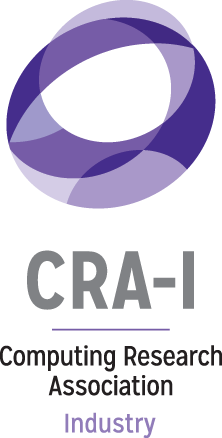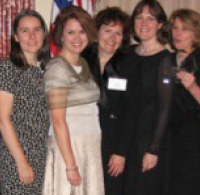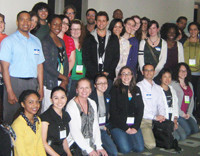Highlight on DREU Alum, Christine Alvarado
Originally Posted in Summer/Fall 2012 Newsletter
Christine Alvarado is a Lecturer with Security of Employment (tenured teaching faculty) at the University of California, San Diego. Prior to coming to UCSD in 2012, she was an Associate Professor of Computer Science with tenure at Harvey Mudd College, where she served on the faculty from 2005-2012. Her current efforts are focused on making computers and computing more accessible, from both a usability and education standpoint. Her technical research seeks to develop robust, free-sketch recognition-based interfaces and explores how to resolve the resulting challenges raised by this new interaction modality. In her education activities, she is designing novel introductory computer science curricula to appeal to a broad scientific audience, with a particular emphasis on increasing the number of women and other underrepresented minorities in computing. Her work has been funded by an NSF CAREER award (2005) and an NSF CPATH award (2009).
Dr. Alvarado received her undergraduate degree in computer science from Dartmouth in 1998, and Master of Science and Ph.D. degrees in computer science from MIT in 2000 and 2004, respectively. She was part of the College Board’s commission and item development team for the new AP CS: Principles course, and she currently serves as co-chair of the National Center for Women & Infor-mation Technology (NCWIT) Academic Alliance.
Q: How did you become interested in pursuing a research career in computer science?
Growing up, a career in computer science was the last thing I thought I would have. I knew computers were the future, but I didn’t want anything to do with them. I remember telling my parents when I was about 11 or 12 how much I hated comput-ers and how I was going to have the only career that existed when I grew up that did not involve computers.
The problem was that I had no idea what computer science was. I didn’t see the point of computers—as far as I knew, you used them to type up papers and play games, neither of which I wanted to build a career around. However, when I took my first computer science class (AP CS, in high school), I suddenly fell in love. I loved the puzzle aspects of solving problems and programming. When I took a few more classes in college and started to understand the rich nature of the field, I was hooked.
I got interested in research in particular because I wanted to become a professor. Back in college, I didn’t really know what that meant other than that I would get to teach students, but as I learned more, I loved the freedom that comes with finding your own interesting problems to solve and trying to create solutions that no one has been able to create before.
Q: How did your experience with DREU influence your career path?
The summer I spent in the DREU program back in 1997 (when it was still called the Distributed Mentor Program) was a huge boost to my confidence. I remember that summer very vividly and fondly. I worked with Professor Nancy Leveson and her students Molly Brown, Denise Pinnel ,and Sean Sandys (I can’t believe I still remember all their names!) at the University of Washington, developing software to help visualize aspects of flight plans to help make air travel safer.
Throughout the summer, I often felt like I didn’t quite know what I was doing, which I learned later, is pretty typical for research! I didn’t think I had done anything that great, so I was surprised at my adviser’s positive reaction to my work. I think I had really high expectations for myself, believing that people who did research somehow did something on a differ-ent level—something I was not capable of doing. Of course, I still feel that way from time to time, but that summer started to teach me that research is just made up of a long string of consistent efforts just like the work I had done that summer.
I also learned that summer that grad school could be a lot of fun. Sean, Molly, and Denise did a great job of including me in both their research group and their social activities. I got to see all of the ups and downs that come with grad school and I began to feel it was a path I was looking forward to trying.
Q: Can you tell us a little about your research and how you choose your research topics?
As a person who loves to explore and hates to be tied down to any one area, I currently have two completely separate research efforts. The first area, pen-based interfaces, grew out of my Ph.D. work. I explore how to build systems that can understand hand-drawn diagrams in order to allow people to interact with those diagrams on the computer in a meaningful way. My team at Harvey Mudd and I have spent the last 6 years building a system called LogiSketch, which allows students to freely draw digital circuits and then simulate those circuits to see how they behave. This effort involved both recognition challenges (how to get the computer to recognize what are often extremely messy drawings that vary a lot from user to user) and user interface challenges (how to allow the user both to edit and draw with the pen efficiently and naturally). I enjoy this research area because it presents significant challenges on both sides, again allowing me to explore two quite different (but obviously related) areas at the same time.
My second area grew out of my love for teaching and my pas-sion to bring computer science to a more diverse set of stu-dents. I have been exploring and developing both curriculum and programs to attract and retain more women and under-represented minorities in computer science. As part of this effort, my colleagues and I at HMC developed a new breadth-first introductory computer science course, nicknamed “CS for Scientists,” aimed at both majors and non-majors alike. We also developed two co-curricular programs—research experi-ences for rising sophomores and trips for first-year women to the Grace Hopper Celebration of Women in Comput-ing. Together, this new course and these new programs have increased the percentage of women in the CS major at HMC from 13% to around 40%.
Q: Can you tell us about your NSF CPATH-funded work? What were the outcomes?
The NSF CPATH-funded project, which is a joint project with my colleagues Ran Libeskind-Hadas, Zach Dodds, and Geoff Kuenning at Harvey Mudd College, aims to take the success we have had with our CS for Scientists class at HMC and bring this class and its outcomes to a broader audience. We have explored how to adapt the course for different environments and in different contexts including a shortened version of the course, the course with a biology theme and an IT theme (two separate offerings), and a high-school version of the course. We have created course materials for several different offerings so that more schools can adapt the version of the course most appropriate for them. So far a number of schools have started offering it including Northwestern and Bucknell.
Over the three years of the project, the focus has evolved to encompass middle school computer science education as well. Zach Dodds and Mike Erlinger (also at HMC) have developed a set of curricular materials called MY CS (Middle Years CS). They are working with middle school teachers in the Pomona school district to offer this course in schools with a large percentage of students from underrepresented groups.
Q: Harvey Mudd has been particularly successful at attracting (and retaining) women and minorities to computer science. Can you tell us more about both the institutional and curricular influences you believe are key to the success?
The key programs that have led to this gender balance are those that I described above: a new CS1 course that show-cases the broad field of computer science, summer research experiences for women in the summer after the first year to give these students confidence, and trips to the Grace Hopper Celebration for first-year undeclared women, to expose them to the vibrant community of CS in general and women in CS in particular.
Another obvious factor is that HMC has Maria Klawe as its president. She has been integral to this success through both her personal and institutional leadership, including providing funding for many of the key initiatives.
In addition, HMC has a faculty that is extraordinarily enthusiastic and willing to put in the effort that it takes to effect institutional change like this. None of those programs were simple to implement, yet everyone embraced them without really a second thought. I’ve never met a group of people more committed to working hard for the benefit of the students.
Q: How do you balance life outside of work with your career objectives?
Heh, so this question couldn’t come at a more appropriate time, as I juggle a move, a new job, a 4-month-old (with no daycare yet), and a 3-year-old, all while my husband and I are traveling (individually) about twice as many days as we are home this summer.
Anyway, this is one of my favorite questions, and I get asked it a lot because people think (for some reason that I honestly can’t quite figure out) that I have it all together. Just for the record, I don’t. Or at least not any more than anyone else. These days my life feels much more like controlled chaos than something in balance.
The two most important things that I do to achieve balance are (1) to decide to have balance and (2) to surround myself with people who make that balance possible.
With regard to the first point, I have known for a long time that I am the only one who can make balance happen in my life. It’s not about anyone else’s expectations of me, or what they say I have to do. At the end of the day, it’s up to me to decide how I want to spend my time, and so I have always made sure that I devote enough time to work, exercise, my family, and my leisure activities, even if that means I don’t always do everything I might want or others might expect me to do in each category. That being said, I have learned to maximize my efforts on every front, knowing what’s most important to get done and knowing when to cut a corner or to say “no.” I am also highly efficient and focused on what-ever activity I am currently doing. For example, I don’t dilute my work time by surfing the web (well, not that much), just like I don’t dilute my family time by checking my email on my phone.
With regard to the second point, even though I believe balance is ultimately self-motivated, it cannot be achieved alone. I am lucky that my husband Alex Snoeren (also a professor of computer science at UCSD) really does half the work in raising our kids and running our home. I have also had supportive colleagues who always understood (and even filled in) when I had to cancel meetings and even classes to run off and deal with sick children and other life events.
Q: What are your future career plans?
Since I just started at UCSD, I sort of see this job as my future career plans, at least in the short term. I would like to try to take some of the programs I helped develop at Harvey Mudd and implement versions of them at UCSD to see if they will have the same positive effect on the number of women in CS here. Longer term, I would really like to go into administration. I’d love to be the dean of faculty at a liberal arts college like Harvey Mudd. As much as I love teaching, I also really love the challenge that comes from designing and implementing large-scale programs, and I would love to think about and manage the intricate details and interactions involved with providing a world-class education for hundreds or thousands of students.
Q: Do you have any other involvement in activities supporting women in computing?
Definitely. I am currently serving as co-chair of the National Center for Women & Information Technology’s Academic Alliance. I’ve also started to get involved with UCSD’s very active and large Women in Computing (WIC) group as faculty co-adviser. I love sports and exercise. I do distance running – half marathons, and the occasional marathon. I also love swimming, and hope to join the masters’ swimming program at UCSD. Every so often I’ll throw in some biking and do a triathlon, but I am a good swimmer and a really bad cyclist, so it’s really depressing to get passed that much on the bike leg.
I also enjoy baking, reading, and occasionally watching some TV, and of course hanging out with friends when I have time left.
Q: Do you have any advice for someone who might wish to follow your career path (or other career path advice)?
My first piece of advice is some meta-advice: Advice is just a suggestion—if it doesn’t feel right, then you don’t have to follow it. My stress level went way down once I had that revelation, and I realized I didn’t have to do everything that people advised me I should do.
Next, I think it’s important to choose your own path, and try not to compare yourself to others. You have your own unique circumstance, so what others do or don’t do shouldn’t really affect your life. It’s really hard for me to follow my own advice here, but I do strongly believe in it so I try.
Finally, have a general plan for your career, but then go with the flow and don’t be afraid to take big steps that feel right, even when they might seem a little risky or “not in the plan.” In my career so far, I’ve taken a job 120 miles away from my husband’s job, I had my first son before tenure (even with the 120-mile combined commuting situation), and I left my secure dream job for a less-certain job opportunity with great potential (and a shorter commute!). I never would have foreseen any of these moves, and others probably thought I was a little crazy, but I have never regretted any of them.






